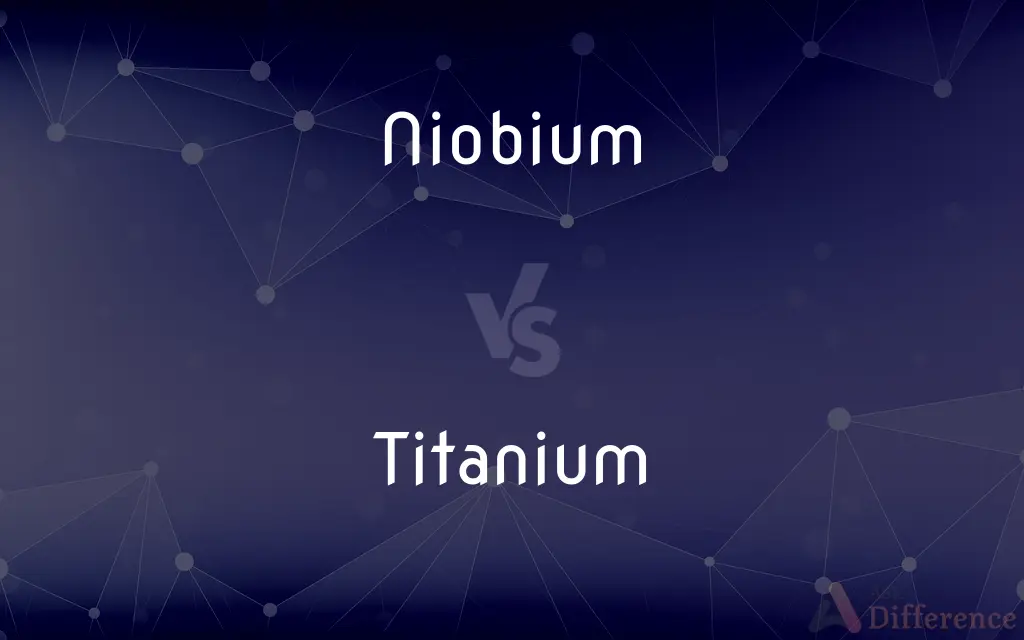Niobium vs. Titanium — What's the Difference?
Edited by Tayyaba Rehman — By Urooj Arif — Updated on April 26, 2024
Niobium is a rare, soft metal used in superalloys and superconductors, while titanium is a strong, lightweight metal known for its corrosion resistance and use in aerospace.

Difference Between Niobium and Titanium
Table of Contents
ADVERTISEMENT
Key Differences
Niobium is primarily valued for its unique properties in enhancing the strength of steel when used as an alloying element. It contributes significantly to the high-temperature strength and low temperature ductility of various steels. Titanium, on the other hand, is renowned for its strength-to-weight ratio, which is one of the highest among metals, making it ideal for aerospace, military, and medical applications.
Niobium is also notable for its superconducting properties when alloyed with tin or other elements, making it essential in the production of superconducting magnets used in MRI machines and scientific research facilities. Titanium, whereas, does not share these superconducting properties but offers exceptional resistance to corrosion, even in challenging environments like seawater or chlorinated water, enhancing its utility in marine and chemical processing industries.
In terms of availability, niobium is less abundant than titanium, with major deposits found primarily in Brazil and Canada. This relative scarcity contributes to its higher market price. Conversely, titanium is more widely distributed around the world with significant deposits in Australia, Canada, and Norway, facilitating a broader range of applications and somewhat lower cost.
Niobium's applications extend into the realm of jewelry and coinage, where it is prized for its ability to be anodized, producing a wide array of colors. Titanium is similarly valued in the jewelry industry, not only for its hypoallergenic properties but also for its durability and the ability to be anodized, offering aesthetic qualities alongside practical benefits.
The processing of niobium often involves complex procedures due to its reactivity at high temperatures, requiring careful handling during melting and fabrication. Titanium, while also challenging to process due to its strength and reactivity, benefits from advanced techniques like the Kroll process, which has improved its usability and widespread adoption in various industries.
ADVERTISEMENT
Comparison Chart
Primary Use
Superalloys, superconductors
Aerospace, medical implants
Strength
Enhances strength of steels
High strength-to-weight ratio
Corrosion Resistance
Moderate, varies with compounds
Excellent, especially in saline environments
Abundance
Less abundant, primarily in Brazil and Canada
More abundant, with deposits worldwide
Processing
Complex due to high reactivity at temperatures
Complex but facilitated by processes like Kroll
Compare with Definitions
Niobium
Essential in superconducting materials for advanced scientific equipment.
Niobium-tin alloys are crucial for making the superconducting wires in MRI machines.
Titanium
Important for aerospace applications.
The spacecraft's hull utilizes titanium for its durability and lightness.
Niobium
Less common in the Earth's crust, primarily sourced from specific regions.
The majority of the world's niobium comes from mines in Brazil.
Titanium
A chemical element with symbol Ti and atomic number 22, noted for its high strength and low density.
Titanium is widely used in aircraft construction due to its lightweight nature.
Niobium
Used as an alloying element in steel to enhance its strength.
The bridge's strength comes from its niobium-reinforced steel beams.
Titanium
Exhibits exceptional resistance to corrosion.
Titanium valves are used in the marine industry because they withstand saltwater corrosion.
Niobium
A chemical element with symbol Nb and atomic number 41, known for its softness and ductility.
Niobium is often used in the production of high-grade structural steel.
Titanium
Available more abundantly than niobium and easier to extract.
Titanium mining is extensive in countries like Australia and Canada.
Niobium
Niobium, also known as columbium, is a chemical element with the symbol Nb (formerly Cb) and atomic number 41. Niobium is a light grey, crystalline, and ductile transition metal.
Titanium
Titanium is a chemical element with the symbol Ti and atomic number 22. Its atomic weight is 47.867 measured in daltons.
Niobium
A silvery, soft, rare, ductile metallic element that occurs chiefly in columbite-tantalite and is used in steel alloys, arc welding, and superconductive materials. Atomic number 41; atomic weight 92.906; melting point 2,477°C; boiling point 4,744°C; specific gravity 8.57; valence 2, 3, 5. See Periodic Table.
Titanium
A strong, low-density, highly corrosion-resistant, lustrous white metallic element that occurs widely in igneous rocks and is used to alloy aircraft metals for low weight, strength, and high-temperature stability. Atomic number 22; atomic weight 47.87; melting point 1,668°C; boiling point 3,287°C; specific gravity 4.51; valence 2, 3, 4. See Periodic Table.
Niobium
A chemical element (symbol Nb) with an atomic number of 41: a light grey, crystalline, ductile transition metal used in superconducting materials.
Titanium
A chemical element, atomic number 22; it is a strong, corrosion-resistant transition metal, used to make light alloys for aircraft etc.
Niobium
(countable) A single atom of this element.
Titanium
(countable) A single atom of this element.
Niobium
The chemical element of atomic number 41. Chemical symbol Nb. Atomic weight 92.91. Previously called columbium. See also Columbium.
Titanium
An elementary substance found combined in the minerals manaccanite, rutile, sphene, etc., and isolated as an infusible iron-gray amorphous powder, having a metallic luster. It burns when heated in the air. Symbol Ti. Atomic weight 48.1.
Niobium
A soft gray ductile metallic element used in alloys; occurs in niobite; formerly called columbium
Titanium
A light strong gray lustrous corrosion-resistant metallic element used in strong light-weight alloys (as for airplane parts); the main sources are rutile and ilmenite
Niobium
Capable of being anodized to produce various colors.
Niobium jewelry is popular due to its vibrant, anodized finish.
Titanium
Also used in medical implants due to biocompatibility.
Titanium is preferred for hip replacements because it is not rejected by the human body.
Common Curiosities
Why is titanium preferred in aerospace?
Titanium is favored in aerospace for its high strength-to-weight ratio and resistance to temperature and corrosion.
What are the main applications of niobium?
Niobium is primarily used in superalloys and superconductors, as well as in steel production to enhance strength and ductility.
How does the cost of niobium compare to titanium?
Niobium tends to be more expensive than titanium, partly due to its rarer occurrence and complex processing requirements.
What makes titanium ideal for medical implants?
Titanium's biocompatibility makes it ideal for medical implants, as it does not react adversely with the human body.
Are there environmental concerns associated with mining niobium?
Like most mining operations, niobium extraction can impact the environment, necessitating responsible mining practices.
Can niobium be used in jewelry?
Yes, niobium can be anodized to produce different colors, making it popular in jewelry for its aesthetic qualities.
Is titanium easy to work with in manufacturing?
Despite its strength, titanium's workability has been enhanced by technologies like the Kroll process, making it more accessible for various uses.
How does the abundance of titanium affect its applications?
Titanium's greater abundance and easier extraction contribute to its widespread use in industries from aerospace to architecture.
What distinguishes niobium's role in electronics?
Niobium's superconducting properties are vital for components like MRI machines and particle accelerators.
How does titanium react to high temperatures?
Titanium maintains high strength and resistance at high temperatures, which is essential for aerospace and industrial applications.
Share Your Discovery

Previous Comparison
Wikipedia vs. Encyclopedia
Next Comparison
Verb vs. NounAuthor Spotlight
Written by
Urooj ArifUrooj is a skilled content writer at Ask Difference, known for her exceptional ability to simplify complex topics into engaging and informative content. With a passion for research and a flair for clear, concise writing, she consistently delivers articles that resonate with our diverse audience.
Edited by
Tayyaba RehmanTayyaba Rehman is a distinguished writer, currently serving as a primary contributor to askdifference.com. As a researcher in semantics and etymology, Tayyaba's passion for the complexity of languages and their distinctions has found a perfect home on the platform. Tayyaba delves into the intricacies of language, distinguishing between commonly confused words and phrases, thereby providing clarity for readers worldwide.















































